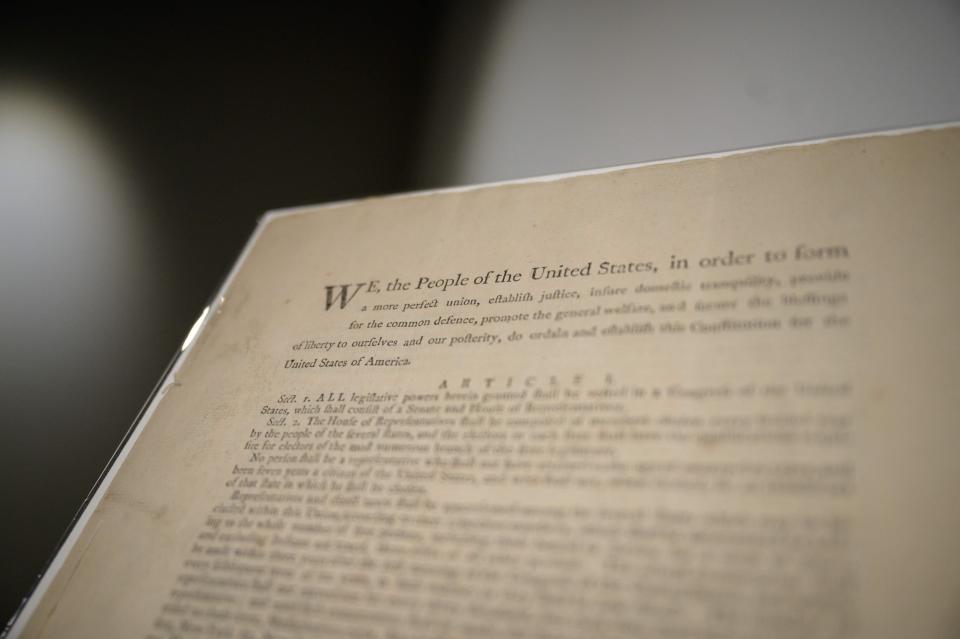When was the Constitution written? Here's a history lesson on the creation of the Constitution
For over 230 years, the Constitution has served as the supreme law of the United States. Before the Constitution, the Articles of Confederation was the ruling document. But it had its problems, including the extremely limited power it gave to the central government.
So, the founding fathers decided to write the Constitution to create an effective, powerful federal government with checks and balances.
But when was the Constitution written and when was it ratified? Here is what you need to know about the U.S. Constitution's creation, plus a rundown of the Bill of Rights.
When was the Constitution written?
The United States Constitution was written in 1787.
It was written during the Philadelphia Convention, now known as the Constitutional Convention. This took place from May 25 to Sept. 17, 1787.

What are the requirements to be president? Qualifications to be the Commander-in-Chief
How many stripes are on the American flag? Here's what the 13 stripes on the US flag represent.
What is the Constitution?
The Constitution is the United States' main framework, defining how the country and its government operates. It is "the world’s longest surviving written charter of government."
The Constitution lays out the structure of the government into three branches: the legislative, executive and judicial. It provides a system of checks and balances for separation of power.
It also contains laws, regulations and rules under which the U.S., its citizens and government are provided and must follow.
When was the Constitution ratified?
The Constitution was ratified in 1788. In order for the Constitution to be adopted, nine of the 13 states had to ratify it.
Ratification is "the process of making an agreement official," according to the Cambridge Dictionary. In order for something to be ratified, the state must approve whatever the item is, whether it be a constitution, treaty or contract law. After ratification, the document is made law and must be followed.
Delaware was the first state to ratify the Constitution on Dec. 7, 1787. After it was ratified by New Hampshire – the ninth state – on June 22, 1788, the Constitution was made official. March 9, 1789, became the official date the Confederation Congress operated under the Constitution.
The last state to ratify the Constitution was Rhode Island on May 29, 1790.
Just Curious? We're here to help with life's everyday questions
What are the three branches of government? Executive, Judicial, Legislative branches explained.
Who wrote the Constitution?
James Madison is often considered the "Father of the Constitution"since he wrote the document that served as the model for the Constitution. Although his ideas and notes were influential, Madison was not the only one to contribute to the Constitution.
According to the Constitution Center, many others made important contributions, especially those on the Committee of Detail and Committee of Style. These include:
Oliver Ellsworth
Nathaniel Gorham
Edmund Randolph
John Rutledge
James Wilson
Alexander Hamilton
William Johnson
Rufus King
Gouverneur Morris
Additionally, George Washington and Benjamin Franklin are noted as other significant delegates who were involved in writing the Constitution.
How old do you have to be to be president? What running for the highest office requires.
How many amendments does the Constitution have?
When the founders wrote the Constitution, they laid out a process where it could be amended, or changed. Today, there are 27 amendments to the Constitution.
What is the highest court in the United States? About the US court system.
What is the Bill of Rights?
The first 10 amendments are known as the Bill of Rights. They were ratified on Dec. 15, 1791. The Bill of Rights outlines civil rights and individual liberties guaranteed to those who live in the U.S.
In simple terms, the Bill of Rights states:
First Amendment: Freedom of speech, press, assembly, protest and religion
Second Amendment: Right to bear arms
Third Amendment: Prohibits military from quartering in private homes
Fourth Amendment: Prohibits government from unreasonable search and seizure of individuals or their private property
Fifth Amendment: Provides rights for criminal and civil proceedings, such as grand jury and no imprisonment without due process of law
Sixth Amendment: Gives additional protections to those accused of crimes, including the right to speedy and public trial and trial by an impartial jury
Seventh Amendment: The right to a jury trial in federal civil cases
Eighth Amendment: Prohibits excessive bail and fines, and cruel and unusual punishment
Ninth Amendment: States that people are guaranteed other rights even if not explicitly listed in the Constitution
Tenth Amendment: States the federal government only has power based on the Constitution. If it isn't listed, the power then belongs to the states or the people.
Preamble to the Constitution
The preamble to the Constitution serves as an introduction to the document. It outlines the intent of the founding fathers and why they created the Constitution.
This is the preamble to the Constitution:
This article originally appeared on USA TODAY: When was the Constitution written? Get to know the US document